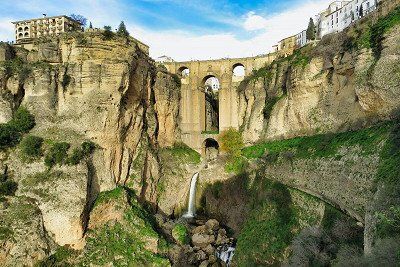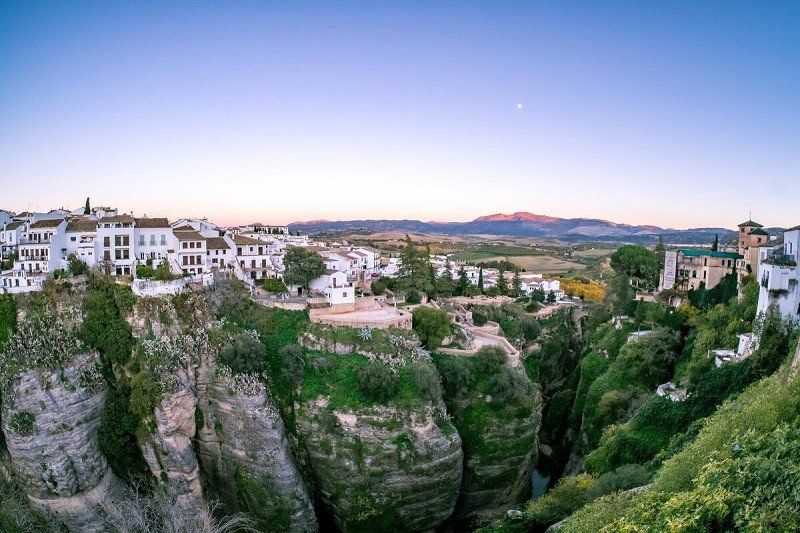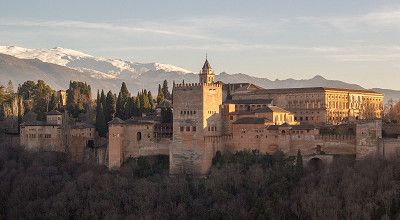Andalusia may be a popular holiday destination, but you can still find insider tips that will take you to unexpected gems in this Spanish region away from the well-trodden paths – and you'll notice soon enough that this Spanish region offers far more than the well-known tourist hotspots. Let Freeontour take you on a journey of colourful rivers, majestic (cave) cities, thermal springs and the place where Christopher Columbus' voyage once began.
What to expect in Andalusia: joie de vivre, oriental flair, passionate flamenco dancing, rich cuisine and multifaceted beauty in every direction. Our tips are for anyone who wants to see the solitary, authentic side of Andalusia while travelling through the region. Or for anyone who simply has time to get to know Andalusia more intimately and has maybe even thought about spending winter here. We recommend holidaying here in the off-season between October and May as you'll have a high chance of escaping the tourist crowds.
You'll find more information on the main sights as well as the best travel times and climate in Andalusia here:

Tip #1: Ronda – a magical city on a rocky plateau
This article's stunning header image is of Ronda. According to Ernest Hemingway, it is the most romantic city in Spain, and Michelle Obama still dreams about her favourite Spanish city, hoping to return here one day. As you can see, Ronda seems to cast a spell over its guests and if you're not careful, you'll fall head over heels in love with the picture-perfect town, too. It towers 723 metres high on a peak in the Serranía de Ronda mountain landscape in the Spanish province of Málaga. So it's hardly surprising that writers like Ernest Hemingway and Rainer Maria Rilke or the film director Orson Wells were inspired by the whitewashed houses, charming alleys and sweeping panoramic views around the city. Hidden away roughly 50 kilometres north of the Costa del Sol, this Moorish town is known for its gorges that are over 100 metres deep, overgrown rocks and artistic stone bridges. This is one of very few cities where you can enjoy a café con leche (milk coffee) in the sun only a few metres away from a deep gorge that you can explore afterwards.
Things to see and do in and around Ronda
- Admire the beautiful and extremely photogenic Puente Nuevo and Puente Romano stone bridges from different perspectives. The former in particular looks magical and is the symbol of the city.
- Stroll through the Old Town, discover handmade treasures in the many narrow streets, take in the architecture, feast your way through the tapas bars and enjoy the spectacular view on the outskirts of the city.

- The area around Ronda is a hiker's paradise. An array of trails go through the Serranía de Ronda. We recommend a tour through the Garganta Verde gorge, which is blessed with the crystal clear Arroyo Bocaleones river, impressive rock formations and occasionally jungle-like vegetation. A hike through the Pinsapar forest will also be a revelation for nature lovers. It is the largest contiguous Spanish fir forest in the world. The bushy, Scandinavian-looking fir trees date back to the Ice Age and have survived by adapting to the Mediterranean climate. A protected hiking trail goes from Grazalema to El Bosque through the Pinsapar forest.
- Ronda played a key role in bullfighting and its bullring is one of the oldest and most beautiful of its kind. The fights were once undoubtedly part of the cultural heritage, but today the locals and tourists are very divided about this bloody and highly controversial tradition. If you're keen to find out more about the history, you can visit the Bullfighting Museum and the bullring where fights still take place during the summer months.
- The Serranía de Ronda is full of vineyards. Even the Phoenicians and later the Romans cultivated viticulture here, which explains why most of the wines produced in the province of Málaga comes from this area. No surprise then that you can drink a variety of wines in and around Ronda in the bodegas (wine taverns) or in rural wineries. The white wines are usually made from the Chardonnay, Colombard, Sauvignon Blanc and Riesling grape varieties, and the red wines from Merlot, Tempranillo, Syrah, Pinot Noir and Romé grapes.
Camping options near Ronda: Área Autocaravanas Ronda caravan site, Camping El Sur campsite

Tip #2: Lanjarón – thermal baths, medicinal springs and mountains
Embedded in the landscape of the Sierra Nevada National Park and roughly 50 kilometres southeast of Granada, Lanjarón is an oasis of calm in the mountains. The town became famous for its medicinal springs, mineral water and hiking trails in lush nature. Lanjarón is also called the city of water and is one of the picturesque white villages of the Alpujarras – a 70 km long valley located at the foot of the Sierra Nevada. The legacy of the Moors who once lived here is still visible in this region, e.g. the whitewashed walls of the houses, their flat roofs and the colourful fabrics that are sold in many shops. If you plan on relaxing and enjoying nature, then the Alpujarras and especially Lanjarón are a must on your itinerary.
Things to see and do in and around Lanjarón
- Visit the traditional Balneario de Lanjarón thermal baths: you can pamper your body and soul in the spa without having to check in to the exclusive spa hotel. There is also a day spa area where you can book individual treatments. Hot (massage) pools, saunas, a hammam, a range of health and beauty treatments, massages and much more await you. The thermal baths are open from March to December.
- Wander through the modern water museum (Museo del Agua) where you can learn more about the town's medicinal water.

- Enjoy the natural mineral water from the city's artistic drinking fountains. It comes straight from the mountains and is rich in minerals, including iron, magnesium and potassium.
- Explore the beautiful Old Town: a charming Moorish-Spanish maze of narrow streets, whitewashed houses and covered paths (tinaos) adorned with colourful flower pots.
- Visit the Castle of Lanjarón: you can reach the ruins of the ancient castle on a waymarked hike that takes about 40 minutes from the city centre. You'll be rewarded by a spectacular view of the city and the surrounding area.
- Go hiking and/or biking: there are numerous hiking and biking trails through the Sierra Nevada. It can snow at higher elevations in winter, so it's best to choose your tours here based on the season.
- Explore other Alpujarra villages on a trip through the valley: some of the most beautiful villages are Pampaneira with its Moorish architecture, Órgiva with Europe's largest hippie community and Bubión with its romantic waterfalls.
Camping options near Lanjarón: Camping Al Firdaus, Camping Orgiva, Camping Trevélez, Camping Balcón De Pitres campsites

Tip #3: Guadix – the city of caves
In the northeast of Granada, surrounded by barren hills of sandstone and tuff amidst the mountain panorama of the Sierra Nevada, lies the town of Guadix. Its cityscape features a mighty cathedral, a Moorish castle and fairytale-like cave dwellings, which are one of the oldest surviving settlements in Spain. Often only white, mushroom-shaped chimneys or whitewashed entrances reveal that there are actually cave dwellings in the rugged rocks. About 4,000 modern cavemen and cavewomen live in 2,000 stone, underground homes in the Barrio de Cuevas, the cave district. Built by the Moors in the 13th century, the cave houses today combine the best of two worlds: modern technology and traditional natural materials. Almost all caves are now equipped with the Internet, hot water and electricity – and you can even visit some of these historically signifiant buildings. The above-ground world in Guadix also has a lot to offer, including hikes through the surreal, barren landscape.
Things to see and do in and around Guadix
- Visit the Cave Museum: head to the cave district, which is about a 20-minute walk south of the city centre. Delve into the fascinating history of this underground city at the Museo Centro de Interpretación Cuevas de Guadix. You can visit a few caves from here, while the museum also offers guided tours of the district.

- You'll go through the traditional pottery district on your way to the troglodyte district. Guadix is known for its pottery, which is still made and sold here today. If you want to find out more, you can visit the Cueva Museo de Alfarería La Alcazaba pottery museum or take part in one of their crafts workshops.
- Visit the proud Cathedral: although its construction began in 1492, it took centuries to complete. This is why its architecture combines elements from the Gothic, Renaissance and Baroque periods. There is a small museum next door that explains the history of the cathedral.
- If you want to enjoy local specialities in an authentic cave, you should visit La Tinaja, a cave restaurant. You will also find many bars and restaurants around Plaza de la Constitución, Plaza los Naranjos and on Calle Jardín.
- Discover the surreal, rugged landscape, e.g. while hiking around Guadix or in the Granada Geopark, which is a UNESCO World Heritage Site.
Camping options near Guadix: Área Autocaravanas Guadix caravan site.

Tip #4: Antequera and limestone mountains
How about combining a cultural jewel with a paradise for nature lovers and hikers? Then head to the city of Antequera around 50 kilometres north of Málaga. It is also the perfect starting point for hikes through Andalusia's impressive limestone mountains. Featuring bizarre rock formations, the Parque Natural de Torcal is only about 15 kilometres from Antequera. There are also wild canyons, millennia-old dolmen sites and a large, well-preserved Moorish fortress not far from the city. Thanks to its favourable location, the locals also refer to Antequera as the heart of Andalusia. The city is very well connected to some of the largest Andalusian towns such as Málaga, Córdoba, Granada and Seville.
Things to see and do in and around Antequera
- Stroll through the picturesque Old Town, relax in one of the many tapas bars and explore the small boutiques.
- If you would like to discover the city from above and on historical paths, you'll find great views of the city from the Moorish castle as well as an insight into the eventful past of this place. You can even listen to an audio guide with your headphones on a walk through the historic walls.

- Visit the dolmen sites. Dolmens are ancient tombs built out of large rocks. There are three in Antequera: the Dolmen de Viera and the Dolmen de Menga are right next to each other, while the Dolmen Tholes de El Romeral is about two kilometres away. The impressive tombs date back to the Bronze Age and are around 6,000 years old.
- Hike through the Parque Natural de Torcal and marvel at the surreal karst formations. They will remind you of Saxon Switzerland and show Andalusia from its rough, untamed side.
- Stargazers should head to the observatory where they can take part in astronomy workshops and nightly events.
Camping options near Antequera: Área Autocaravanas Antequera caravan site, El Torcal de Antequera caravan site, Camping La Sierrecilla campsite, Archidona caravan site

Tip #5: Huelva – Columbus' port and the colourful Río Tinto river
The city of Huelva is located just 50 kilometres east of the Portuguese border. The Tinto and Odiel rivers flow around the port city and eventually feed into the sea. Much like nearby Cádiz, Huelva is one of the oldest and most historic cities in Europe. Even the Phoenicians, Greeks, Romans and Moors valued it as a trading location. Later, the city was under the influence of British colonies. In contrast to Cádiz, however, Huelva is far less known and less touristy. The city and its surroundings have many surprises in store. Its protagonist is Christopher Columbus who set sail from the port of Huelva in 1492 in search of a sea route to India. The region around Huelva is renowned for its beautiful beaches, natural parks and the colourful Río Tinto river. Around 120 kilometres of golden sandy beaches stretch along the coast, yet tourists are still relatively rare – especially in the off-season.
Things to see and do in and around Huelva
- In the footsteps of Columbus at the pier of the three caravels: three museum ships are moored here in remembrance of Columbus: the caravels Pinta, Niña and Santa María. Caravels were types of sailing ships that Europeans used to cross the Atlantic in the 15th century. Columbus set sail from Huelva in 1492 on the Santa María, accompanied by the two flagships Pinta and Niña.

- Try the famous Jamón Ibérico ham in the tapas bars – the Huelva region is one of the areas where this Spanish speciality is produced. The black Ibérico pigs feed on acorns and their ham is considered to be one of the most aromatic in Spain.
- Visit the beautiful beaches near the town, for instance, El Rompido and Isla Canela are two of the most popular sandy beaches for long walks, picnics, water sports and relaxation.
- The Cave of Wonders is an ancient and impressive limestone cave located around 100 kilometres north of Huelva in the white mountain village of Aracena. You can first visit the fascinating underworld and then explore the pretty traditional village.
- The colourful Río Tinto river: Río Tinto means red river because its water is reddish in colour. This comes from the weathering of metallic minerals derived from the ore deposits that are thousands of years old, which the Phoenicians, Romans and Moors extracted from open-pit mines. It's worth visiting both the course of the coloured river and the historic mines – you will literally see red on this day trip.
Camping options near Huelva: Camping Playa la Bota campsite, Parking de Caravanas y Marina Seca Gómez Sabiote caravan park



